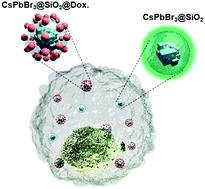当前位置:
X-MOL 学术
›
J. Mater. Chem. B
›
论文详情
Our official English website, www.x-mol.net, welcomes your
feedback! (Note: you will need to create a separate account there.)
Highly luminescent biocompatible CsPbBr3@SiO2 core–shell nanoprobes for bioimaging and drug delivery
Journal of Materials Chemistry B ( IF 6.1 ) Pub Date : 2020-10-01 , DOI: 10.1039/d0tb01833c Pawan Kumar 1, 2, 3, 4 , Madhumita Patel 2, 3, 4, 5 , Chanho Park 1, 2, 3, 4 , Hyowon Han 1, 2, 3, 4 , Beomjin Jeong 1, 2, 3, 4 , Hansol Kang 1, 2, 3, 4 , Rajkumar Patel 2, 6, 7, 8, 9 , Won-Gun Koh 2, 3, 4, 5 , Cheolmin Park 1, 2, 3, 4
Journal of Materials Chemistry B ( IF 6.1 ) Pub Date : 2020-10-01 , DOI: 10.1039/d0tb01833c Pawan Kumar 1, 2, 3, 4 , Madhumita Patel 2, 3, 4, 5 , Chanho Park 1, 2, 3, 4 , Hyowon Han 1, 2, 3, 4 , Beomjin Jeong 1, 2, 3, 4 , Hansol Kang 1, 2, 3, 4 , Rajkumar Patel 2, 6, 7, 8, 9 , Won-Gun Koh 2, 3, 4, 5 , Cheolmin Park 1, 2, 3, 4
Affiliation

|
The encapsulation of lead halide perovskite nanocrystals (PNCs) with an inert protective layer against moisture and the environment is a promising approach to overcome hinderances for their practical use in optoelectronic and biomedical applications. Herein, a facile method for synthesizing highly luminescent and biocompatible CsPbBr3@SiO2 core–shell PNCs with a controlled SiO2 thickness, which are suitable for both cell imaging and drug delivery, is reported. The synthesized CsPbBr3@SiO2 core–shell PNCs exhibit bright green emission at 518 nm upon excitation of 374 nm. Interestingly, a significant increase in the photoluminescence intensity is observed with an increase in the SiO2 shell thickness, which varies with the increasing reaction time. Cytotoxicity results indicate that the CsPbBr3@SiO2 core–shell PNCs are nontoxic, making them suitable for in vitro cell imaging using HeLa cells. Furthermore, doxorubicin physically adsorbed on the surface of CsPbBr3@SiO2 core–shell PNCs is efficiently released in cells when the drug-loaded perovskite nanoprobes are injected in the cells, indicating that these core–shell nanoparticles can be used for drug loading and delivery. The results of this study suggest that the CsPbBr3@SiO2 core–shell PNCs can pave the way for new biomedical applications and processes.
中文翻译:

具有高发光性的生物相容性CsPbBr3 @ SiO2核壳纳米探针,用于生物成像和药物输送
带有惰性防潮层和环境保护层的卤化钙钛矿纳米晶体(PNC)的封装是克服其在光电和生物医学应用中实际使用的障碍的一种有前途的方法。本文报道了一种简便的方法,该方法可合成高度发光且具有生物相容性的,具有受控SiO 2厚度的CsPbBr 3 @SiO 2核-壳型PNC ,适用于细胞成像和药物递送。合成的CsPbBr 3 @SiO 2核-壳型PNC在374 nm激发后在518 nm处显示亮绿色发射。有趣的是,观察到随着SiO 2的增加,光致发光强度显着增加。壳的厚度,随反应时间的增加而变化。细胞毒性结果表明,CsPbBr 3 @SiO 2核-壳型PNC无毒,使其适合使用HeLa细胞进行体外细胞成像。此外,当将载药的钙钛矿纳米探针注入细胞后,物理吸附在CsPbBr 3 @SiO 2核-壳PNC表面的阿霉素可以有效地释放到细胞中,表明这些核-壳纳米颗粒可用于载药和交货。这项研究的结果表明,CsPbBr 3 @SiO 2核-壳型PNC可以为新的生物医学应用和工艺铺平道路。
更新日期:2020-11-03
中文翻译:

具有高发光性的生物相容性CsPbBr3 @ SiO2核壳纳米探针,用于生物成像和药物输送
带有惰性防潮层和环境保护层的卤化钙钛矿纳米晶体(PNC)的封装是克服其在光电和生物医学应用中实际使用的障碍的一种有前途的方法。本文报道了一种简便的方法,该方法可合成高度发光且具有生物相容性的,具有受控SiO 2厚度的CsPbBr 3 @SiO 2核-壳型PNC ,适用于细胞成像和药物递送。合成的CsPbBr 3 @SiO 2核-壳型PNC在374 nm激发后在518 nm处显示亮绿色发射。有趣的是,观察到随着SiO 2的增加,光致发光强度显着增加。壳的厚度,随反应时间的增加而变化。细胞毒性结果表明,CsPbBr 3 @SiO 2核-壳型PNC无毒,使其适合使用HeLa细胞进行体外细胞成像。此外,当将载药的钙钛矿纳米探针注入细胞后,物理吸附在CsPbBr 3 @SiO 2核-壳PNC表面的阿霉素可以有效地释放到细胞中,表明这些核-壳纳米颗粒可用于载药和交货。这项研究的结果表明,CsPbBr 3 @SiO 2核-壳型PNC可以为新的生物医学应用和工艺铺平道路。











































 京公网安备 11010802027423号
京公网安备 11010802027423号